The core principle of metal stamping is to use high-precision mold to press, bend or stretch metal blank into a specific shape, with the advantages of high efficiency, low consumption and good consistency. Metal stampings is widely used in various industries from simple structure parts manufacturing to complex structure parts manufacturing, which proves the irreplaceability of this process in modern industry. In this basic guide, we will further explore the advantages, processes, equipment types and application requirements of metal stamping in various industries.
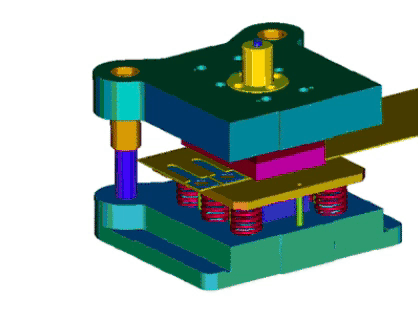
What are the advantages of metal stamping?
1.Precision and consistency
Metal stamps mold adopts CNC machining technology, tolerance accuracy ±0.005mm, suitable for automotive size requirements. The consistency of the product in the mass production process is very high.
2.Productivity
Metal stamps mold can be switched quickly, and with the help of automated presses, a device can produce hundreds of pieces per hour, making it particularly suitable for mass production, such as home appliance casings and 3C product structural components.
3.Cost advantages
The mold can be reused thousands of times, dilutes unit costs over time and achieves material utilization rate over 85%. Compared with CNC cutting, it reduces waste, especially for high value materials such as aluminum alloys and stainless steel.
4.Complex shape processing capability
Through multiple progressive molds, the process of punching, bending and stretching can be completed in one go to realize three-dimensional forming of complex structures, such as irregular curved components of battery trays of new energy vehicles.
5.Cross-industry adaptation
Metal stamps support custom designs, from titanium alloy components for medical devices to aerospace titanium plate stamping, which can be quickly adapted to different industries by adjusting mold parameters.
What is the basic process of metal stamping?
1.Design and mold making
After the customer submits the CAD files as required, the JS team with over 20 years of practical experience will optimize the design scheme to ensure compliance with precision stamping requirements. They use advanced software to design high-precision metal stamper molds that meet the stringent specifications required by customers.
2.Material selection and cutting
According to engineering requirements, from more than 50 metal materials (such as stainless steel, aluminum, copper, etc.) to select the appropriate plate. JS provides a fast material matching service that supports direct queries after product specifications are uploaded, shortening decision time.
3.High-speed stamping
In automatic stamping equipment, stamping, bending, stretching and other processes are completed in a single stamping on metal process. JS's intelligent production line delivers fast delivery in 1-2 weeks, with a 20% efficiency boost, especially for bulk orders.
4.Surface treatment and quality inspection
After stamping, provide burr removal, plating, spraying and other value-added services. JS uses more than 30 quality inspection standards, combined with artificial intelligence vision inspection system, to over 98% product qualification rate and reduce rework.
5.Sustainable production
Using the waste recycling system, energy consumption in stamping process is reduced by 15%, which meets the requirements of environmental protection. In the process, JS saw a 25% annual increase in repeat orders.
What are the types of metal stamping equipment?
1.Hydraulic stamping equipment: Driven by hydraulic system, it is suitable for high-precision stamping of large metal sheets and is commonly used in the production of automobile overlay or heavy machinery structure.
2.Hydraulic stamping equipment: The hydraulic system provides stable pressure, suitable for stamping metal jobs that require high precision, such as the forming of automobile beams and heavy machinery structures. It can adjust the pressure range widely and adapt to different thickness of plate.
3.Mechanical stamping presses: Driven by a crankshaft connecting rod mechanism, suitable for high-speed, large stamping metal production, such as home appliance shell, 3C product metal brackets, etc. It is characterized by high production efficiency and high stability.
4.CNC stamping machines: Integrated numerical control system, programmable control mold path, complex stamping metal processing, commonly used in electronic connectors, LED scaffolding and other precision components mass production.
5.Servo stamping presses: Using servo motors to control stamping stroke and pressure accurately, it is suitable for stamping metal processing of aluminum, magnesium alloys and other lightweight materials, and can save more than 30% energy than traditional equipment.
6.Shearing machines: It is specially designed for cutting metal sheets in a straight line and is often used in the front of a stamping line to process coils or large size plates.
7.Bend machine: It is a commonly used method in folding or 3D structural processing of sheet metal sheets to achieve bending and forming through mold pressing.
8.Fine blanking presses: Through the combination of stamping and shearing technology, a burr free and high-quality stamping metal process, applied to gearbox gears sensor housings shell and other precision components.
9.Laser-assisted stamping systems: The processing efficiency of stamping metal is improved by the combination of laser precutting and stamping, especially for precision processing of irregular surface or high strength steel.
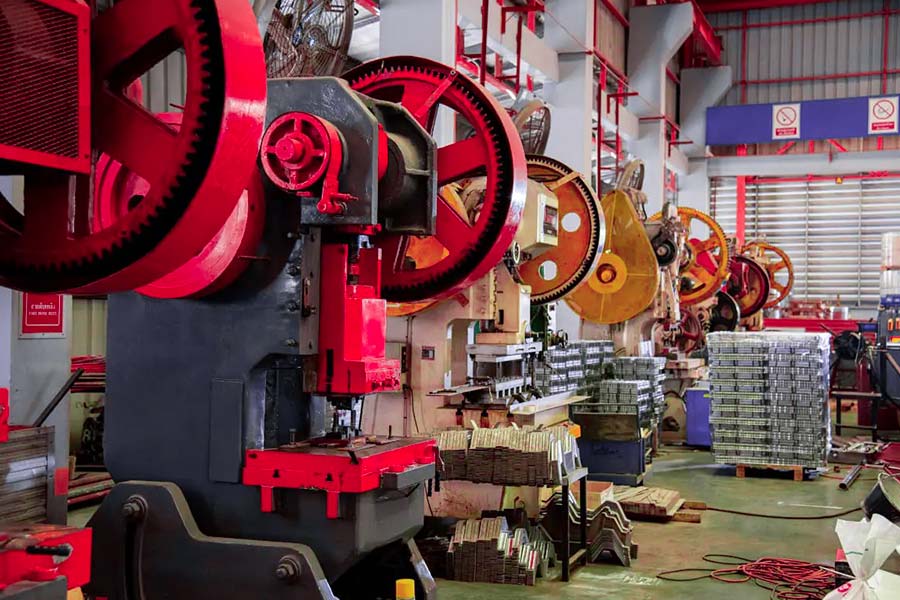
What is the difference between metal stamping and sheet metal fabrication?
1.Principles of process
- Metal stamping directly completes plastic deformation such as stamping, bending and stretching by applying pressure to metal plate through metallic stamp mold and press. Suitable for complex 3D structures such as car bonnets.
- Sheet metal fabrication mainly involves cutting, bending and welding, gradually forming through cutting or bending equipment, often used in simple structures such as chassis shell.
2.Equipment and mould dependency
- Metal stamping relies on high-precision metallic stamp molds and professional presses, which are mold costs but can be reused thousands of times.
- Sheet metal fabrication usually uses CNC laser cutting machines, bending machine and other general equipment, do not need to customize die, so has a high flexibility.
3.Material deformation degree
- Metal stamping realizes complex structure through deep plastic deformation and requires high material ductility of the material.
- Sheet metal fabrication is mainly shallow bending or cutting, suitable for the production of sheet non-standard parts.
4.Efficiency and cost
| Comparison items | Metallic stamping | Sheet metal fabrication |
| Unit cost (mass production) | ≤$0.5 (when producing 100,000 pieces per year | $2-5 (small batch). |
| Single piece production time (seconds) | 0.5-5 (high-speed stamping can reach less than 0.1 seconds). | 30-300 (depending on the process). |
| Mold cost ($Ten thousand) | 5-50 (higher for complex molds). | 0.1-5 (some parts do not require molds). |
| Minimum batch economy |
More than 10,000 pieces.
|
1-100 pieces. |
| Typical production cycle | Mold development takes 2-4 weeks, and mass production starts from 1 week. | Mold free development, single piece processing takes 3-7 days. |
| Material utilization rate | 85% -95% (progressive mold reduces waste). | 70% -90% (cutting loss+corner material). |
| Waste disposal cost |
Low (less waste, high recycling value).
|
High (with a lot of scraps, requiring additional processing). |
5.Surface quality
- Metal stamping can be achieved by means of metallic stamp with micrometer level tolerances (±0.01mm) and smooth burr free surface.
- Because sheet metal fabrication in the multi-process splicing, may appear slight joint tolerance errors.
In short, metal stamping is a subtractive+plastic forming technology driven by metallic stamp, while sheet metal fabrication is a combination of cutting and bending, which complement each other to meet the needs of different industries.
What are the applications of combining composite materials with metal stamping?
1.Car lightweight components
- Application: JS helps car companies reduce weight by more over 30% maintaining crash collision safety combining metal stamping structural components, such as frame crossbeams, with carbon fiber composites. Metal stamping parts are formed by a metal stamp process that provides high rigidity support in key areas, while composite material covers non-bearing areas to reduce overall weight.
- Technical highlights: JS's CNC machining technology can accurately control the tolerance (±0.005mm) of metal punch to ensure seamless connection with composites and reduce assembly errors.
2.Aerospace heat resistant components
- Application example: A satellite project combines titanium alloy punch and ceramic matrix composites for use in rocket engine nozzles. Metal stamping parts can withstand high temperature and pressure environment, while the outer layer of composite material provides thermal insulation.
- Technical highlights: JS's automated production line can complete metal stamping and composite material coating at the same time, shorten the production cycle to 60% of traditional processes and achieve a yield rate of 98%.
3.Consumer electronics cooling module
- Application example: The high-end smartphone heat sink adopts the aluminum alloy stamping frame and graphene composite integrated design. Metal stamping parts are processed by metal stamp technology to ensure the electromagnetic shielding performance of the finished product, while composite materials effectively conduct heat.
- Technical highlights: JS's precision machining technology can achieve 0.02mm of micropore processing to meet the density requirements heat dissipation holes, while reducing overall thickness by 0.5mm through material composite.
4.Medical devices
- Application example: Stainless steel stamping frame and PEEK composite material for external fixation support of orthopedics. Metal stamping parts provide precise support, while composite materials reduce weight and prevent X-ray interference.
- Technical highlights: JS's flexible manufacturing system supports small volume customization of production, up to 7 working days from design to delivery, and serves multiple international medical device manufacturers.
5.New energy storage systems
- Application example: The battery shell adopts the composite structure of aluminum magnesium alloy punch and fiberglass composite to ensure mechanical strength and improve corrosion resistance.
- JS's process can reduce the weight of the casing by 18% while improving battery life through simulation.
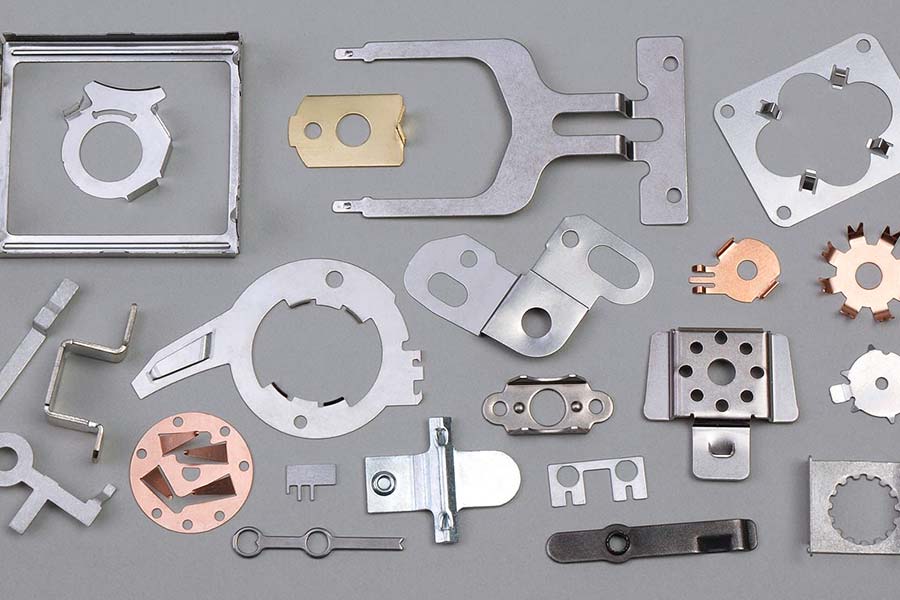
What are the requirements for stamped parts in medical devices?
The medical device industry has extremely strict requirements for the performance, accuracy and safety of metal stamped parts, which must meet the following key standards:
1.Material biocompatibility
- Metal stamped parts shall use medical-grade materials (e.g. 316L stainless steel, medical polymer materials) to ensure non-toxicity, corrosion resistance and biocompatibility in accordance with ISO 10993 standards.
- For example, Stamping part of an orthopedic implant needs to be cytotoxicity and sensitization tests to avoid rejection reactions.
2.Dimensional accuracy and surface smoothness
- Metal stamped molds must have tolerances ±0.01mm and surface roughness Ra ≤0.4μm to avoid scratching tissue or affecting instrument function.
- Example: The incision of the surgical forceps needs to be polished to achieve a mirrored effect and prevent tissue from sticking during surgery.
3.Aseptic and clean production
- Stamping is completed in a dust-free workshop (stage 1000), and metal stamped parts need to be cleaned, passivated and sterilized (e.g. ethylene oxide or irradiation) to ensure no residual contaminants.
- For example, stamping part of heart stents must comply with the ISO 13485 cleanliness standard to avoid the risk of blood clots caused by particle contamination.
4.Surface functionalization treatment
- Through PVD coating and micro arc oxidation, the abrasion resistance or antimicrobial resistance of metal stamped parts can be enhanced to meet special clinical needs.
- Example: Endoscopes are coated with a titanium nitride layer to reduce friction coefficient and inhibit bacterial growth.
5.Accreditation and traceability
- Metal stamped parts must comply with regulations such as FDA 21 CFR Part 820 and CE MDR, and provide complete production batch records and documentation of material traceability documents.
- Example: Disposable syringe stamping parts need a unique serial number to support full lifecycle traceability.
Technical difficulties and solutions
| Challenge | Metal stamped response plan |
| Complex shaped parts forming | Multi station progressive die+servo press to achieve micrometer level precision control. |
| Ultra thin material processing | Nitrogen assisted stamping process is used to reduce the rebound of aluminum/titanium alloy sheets. |
| High frequency sterilization tolerance | Optimize the surface coating process of mold surface and improve the corrosion resistance and fatigue resistance of stamped parts. |
What are the restrictions on stamping materials for engine blades?
1.High temperature stability
Leaves need to work in a high temperature (800°C to 1100°C) gas environment for a long time, the material needs to resist creep, oxidation and low thermal expansion coefficient.
- Typical materials: Nickel based superalloys (such as Inconel 718), titanium alloys (Ti-6Al-4V).
- Technical response: JS company uses vacuum heat treatment and surface coating (such as DLC or ceramic coating) to improve the material's high temperature resistance.
2.Mechanical strength and fatigue life limitations
- The blades need to withstand centrifugal force, vibration, and thermal stress, and the materials need high yield strength (≥800MPa) and excellent fatigue resistance.
- Typical materials: ultra-high strength steel (e.g. Maraging Steel), directional solidification alloys.
- Technical response: JS's precision stamping equipment achieves micrometer level tolerance control (± 0.005mm), reducing the risk of stress concentration.
3.The contradiction between lightweight and specific strength
- Density must be reduced while maintaining strength to increase the thrust to weight ratio of the engine.
- Typical materials: Titanium alloy, carbon fiber reinforced composites (CFRP).
- Technical response: JS adopts topology optimization design to embed lightweight composite reinforcement ribs in metal stamping parts to reduce weight by over 20%.
4.Material processability limitations
- High-strength materials, such as nickel alloys, have severe job hardening and are prone to cracking, while titanium alloys exhibit significant knife stabbing.
- Technical response: JS uses gradient stamping technology, combined with professional lubricating oil and multi-process forming technology, to reduce the risk of material tearing.
5.Corrosion resistance and oxidation limitations
- Sulfide and chloride in gas can easily cause material corrosion and shorten blade life.
- Typical material: Corrosionresistant alloys such as Hastelloy X, surface nitrogen treatment.
- Technical response: JS's precision cleaning and passivation process can remove stamping residue and combine with anodic oxidation to improve corrosion resistance.
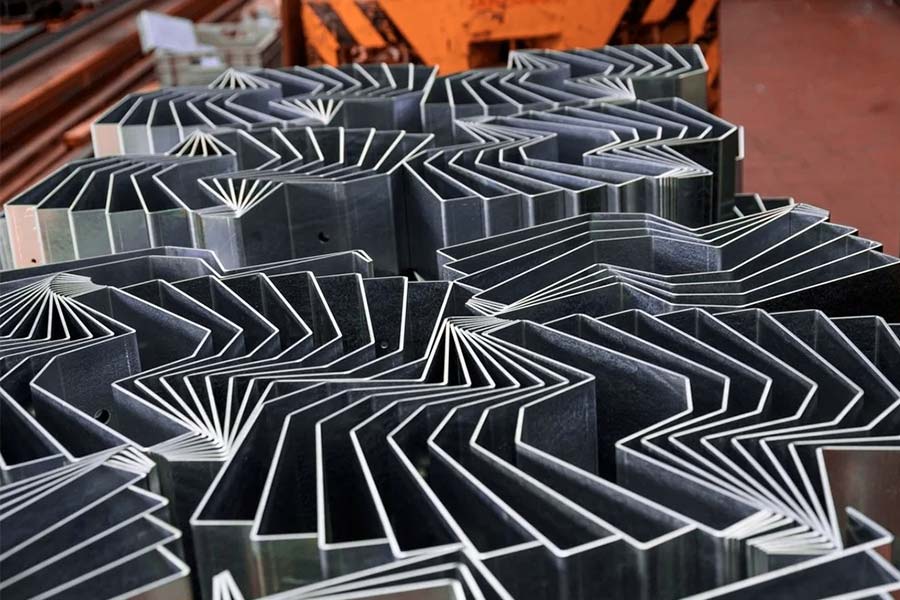
How does JS's material library match the needs of the automotive industry?
Core advantages of JS material library
1.High-strength and lightweight materials
- Typical materials: 6 series/7 series aluminum alloy, titanium alloy, carbon fiber composite.
- Application scenarios: Body coverings, battery pack Case, suspension system Component.
- Strengths: 30%-50% weight loss, improvement, a tensile strength over 600MPa.
2.Corrosion resistant and high-temperature resistant materials
- Typical materials: 316L stainless steel, 625 heat resistant alloy, PEEK plastic.
- Application scenarios: Exhaust system components, high temperature bracket for electric drive system, fuel cell bipolar plate.
- Strengths: Spray corrosion resistance of more than 2,000 hours, long-term working temperature up to 300℃.
3.Precision processing specialized materials
- Typical materials: Copper alloy (C18150), mold steel NAK80, optical grade PMMA.
- Application scenarios: Sensor precision Shell, motor gears, car light reflectors.
- Advantages: Processing tolerance ±0.005mm, surface roughness Ra <0.4μm.
4.Environmentally friendly and sustainable materials
- Typical materials: Recycled PA66, biobased PLA, low VOC ABS.
- Application scenarios: Interior, charging station housing, child safety seats, etc.
- Strengths: Reduced carbon emissions by 40% and EU RoHS certification.
Material solutions for the automotive industry
| Industry demand | JS material solution | Automotive industry adaptation cases |
| Lightweight | Aluminum alloy+topology optimization design. | A new energy car company has lost 3.2kg of battery pack weight and increased its range by 15%. |
| Wear resistance | POM+DLC coating. | Automatic transmission valve body lifespan has been extended to 800,000 kilometers. |
| Electromagnetic shielding | Nickel plated graphite fiber. | the onboard ECU improved anti-jamming by up to 40dB. |
| Rapid iteration | 3D printing nylon prototype. | New air conditioning vents have a 60% reduction in the validation cycle. |
Differentiation in JS
- Technology integration capability: Seamless integration CNC machining, 3D printing, surface processing and other technologies to achieve integrated manufacturing of complex parts.
- Materials Database: A physical/chemical performance database covering more than 50 materials that supports the selection of AI assisted materials.
- Sustainability certification: 100% material traceability through IATF 16949 and ISO 14001 system certification.
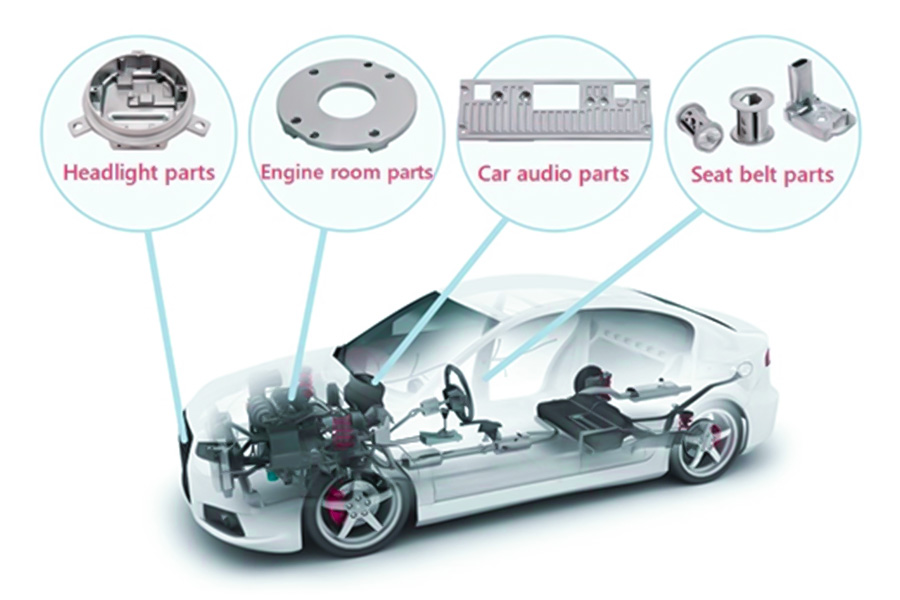
Summary
Metal stamping, as the cornerstone process of modern industry, has permeated dozens of fields such as automobile, electronics, healthcare, aerospace and so on. Regardless of the type of complex and irregular structures, stamp metal technology achieves one-off molding of complex structures by balancing strength, precision and cost efficiency through the synergy of high-precision molds and presses.
In the future, as smart factories and green manufacturing advance, stamp metal will continue to define the limitless possibilities of industrial manufacturing in an efficient and low-carbon manner.
Disclaimer
The content on this page is for general reference only. JS Series makes no express or implied warranties regarding the accuracy, timeliness, or applicability of the information provided. Users should not assume that the product specifications, technical parameters, performance indicators, or quality commitments of third-party suppliers are completely consistent with the content displayed on this platform. The specific design feature, material standards, and process requirements of the product should be based on the actual order agreement. It is recommended that the purchaser proactively request a formal quotation and verify product details before the transaction. For further confirmation, please contact our customer service team for professional support.
JS Team
JS is an industry leading provider of customized manufacturing services, dedicated to providing customers with high-precision and high-efficiency one-stop manufacturing solutions. With over 20 years of industry experience, we have successfully provided professional CNC machining, sheet metal manufacturing, 3D printing, injection molding, metal stamping and other services to more than 5000 enterprises, covering multiple fields such as aerospace, medical, automotive, electronics, etc.
We have a modern factory certified with ISO 9001:2015, equipped with over 100 advanced five axis machining centers to ensure that every product meets the highest quality standards. Our service network covers over 150 countries worldwide, providing 24-hour rapid response for both small-scale trial production and large-scale production, ensuring efficient progress of your project.
Choosing JS Team means choosing manufacturing partners with excellent quality, precise delivery, and trustworthiness.
For more information, please visit the official website: jsrpm.com
FAQs
1.What is the definition of metal stamping?
The process of manufacturing parts by applying pressure on metal materials by mould and press is characterized by high precision and high efficiency.
2.Key points of stamping mold design?
In order to optimize processing cost and production efficiency, attention should be paid to reasonable structure, material strength and abrasion resistance, accurate control of suitable clearance and slope removal, and ensure stamping accuracy, mold life and operation safety.
3.What are the characteristics of aerospace stamping parts?
High-strength and lightweight materials (titanium alloy/hyperalloy), precision molds, multi-process stamping are required, with high temperature resistance, high pressure resistance, micrometer level tolerances, lightweight structure, etc.
4.What are the application fields of metal stamping?
Widely used in automotive, electronics, home appliances, medical, aerospace, new energy, construction, manufacturing structural components, precision parts, lightweight components and other fields.
Resources






